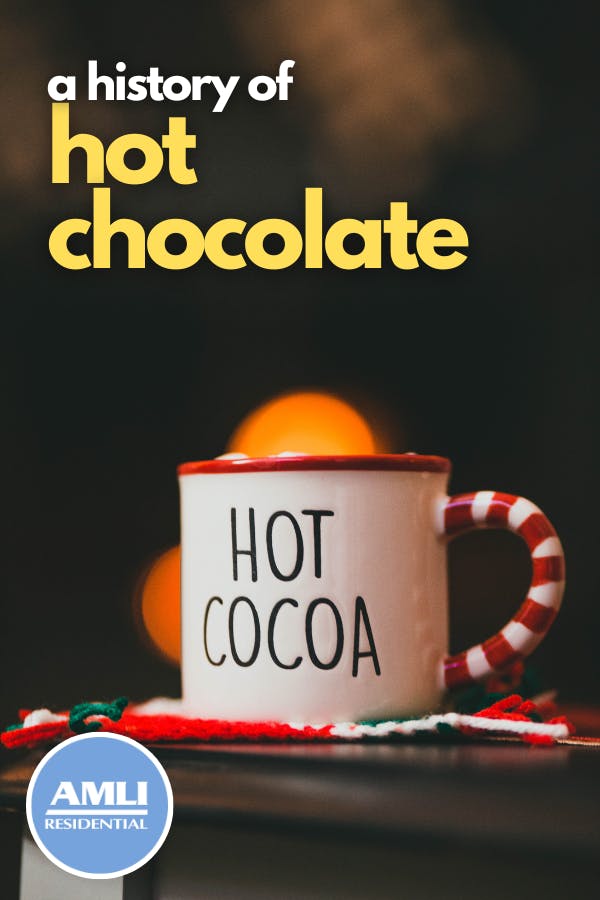It’s warm, it’s cozy, it’s a staple every winter and it’s, objectively, the best drink in the world.
Okay, so maybe it’s not the best, but it’s still one of the more popular warm drinks out there, so it deserves a bit of time in the limelight.
Here’s a brief history of hot chocolate, including where it came from, how it was first enjoyed, who popularized it and, of course, how it evolved into the cozy drink we have today.
Where did hot cocoa come from, anyways?
Early chocolate
Interestingly enough, chocolate actually started out as hot chocolate long before it ever became a snack to eat. Historically, it’s known to have originated with the peoples of Central America, though there’s even some evidence that suggests the cacao-based drink predates even those ancient cultures!
Either way, that’s a pretty good place to start.
Let’s head back in time to ancient Central America and to the societies of the Mayans, Olmecs and Aztecs starting around 500 B.C. Here, cocoa beans were considered a currency and were often traded for other high-value items. Because of their importance in the culture and economy of these early nations, the cocoa bean symbolized wealth and power, and only the extremely wealthy could afford to use the beans for consumption. Both the Mayans and Aztecs created and consumed some form of drink made from these cocoa beans — it included ground cocoa, water, cornmeal and chili peppers, as well as flavors from vanilla, cinnamon and flowers that were available regionally. The mixture would be heated and poured back and forth between a hot pot and a smaller cup over and over until a thick foam developed over the drink, after which it would be enjoyed cold.
This early version of hot chocolate was nothing like the cozy cup of hot cocoa we enjoy in front of a cracking fire. This drink was bitter, strong and spicy, which is likely why the Aztecs and Mayans called the drink cacahuatl and xocōlātl, respectively, both meaning “bitter water.” This is probably where the word chocolate itself came from, too.
Chocolate in 16th century Europe
As with most foods, drinks, spices and resources, this chocolate drink made its way over to Spain in the early 1500s when Spanish conquistador Hernán Cortés (full name Hernán Cortés de Monroy y Pizarro Altamirano) met with King Montezuma of the Aztecs in 1519. The encounter ended with war — surprise, surprise — and what followed was the Spanish conquest of the Aztec Empire through what is now known as the Spanish-Aztec War.
Among the spoils of war Cortés brought back to Spain was the curious, bitter cocoa bean and the drink that he shared with King Montezuma before promptly murdering him.
Chocolate, as the drink was simply called, spread quickly through the Spanish upper class, who thought the drink to be an aphrodisiac due to the drink’s exotic and mysterious nature. Its bitter flavor and pepper-y heat made it a popular cure for upset stomachs, and many Spanish aristocrats drank a cup of the strong drink every day with their morning meal.
Over the next century or so, the Spanish added small adjustments to the base chocolate recipe. Some began adding honey, some took out the chili peppers, some boiled the drink with red wine and some added sugar. Over time, the chocolate drink evolved to include sugar and sweeteners and exclude the chili peppers and cinnamon, though the notes of vanilla remained a popular addition. The drink never made it far outside the country, though, as cocoa was still considered to be a valuable resource from the Spanish New World.
18th century advancements in chocolate production
It was the early 1700s when the chocolate drink finally made its way to London — and the English loved it. Chocolate houses popped up all over the city where the hot, bitter drink could be enjoyed by only the very wealthy who could afford the trendy-yet-exclusive beverage.
After that, chocolate began to take many different shapes and forms as people experimented and adjusted the beverage to their liking. One of the biggest alterations can be credited to Sir Hans Sloane who, upon returning from the Caribbean, brought with him the Jamaican technique of mixing the bitter chocolate drink with milk. The milk, combined with the sugar and vanilla, took the chocolate drink to a whole new level.
The rest, as they say, is history!
Hot chocolate today
Today, hot chocolate, hot cocoa, cacao and other versions of this drink are enjoyed all over the world in many different forms. People in the Philippines enjoy tsokolate, which is made by dissolving roasted cocoa beans in milk and water. In Colombia, a frothy, milky hot chocolate is a popular drink at breakfast and accompanied by soft cheese, while Argentinians enjoy their submarino by dunking a piece of chocolate into hot milk with sugar. Viennese hot chocolate — called heiße schokolade wiener art — includes an egg yolk for extra creaminess.
Wherever you are and however you like your hot chocolate prepared, just know that you’re enjoying an ancient drink that dates back thousands of years to some very special cultures and times! Try your hand at some regional varieties, or give the OG recipe a go here!
Cheers!
Pin it!

Featured photo courtesy Pixabay/Pexels


 View All Posts by Colleen Ford
View All Posts by Colleen Ford